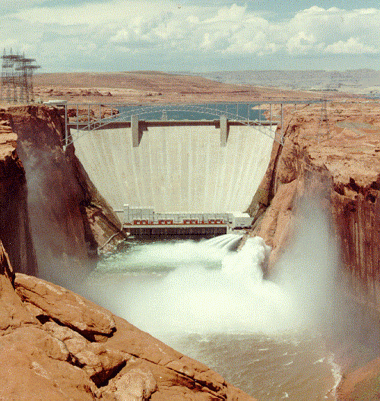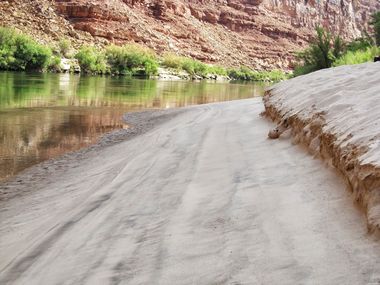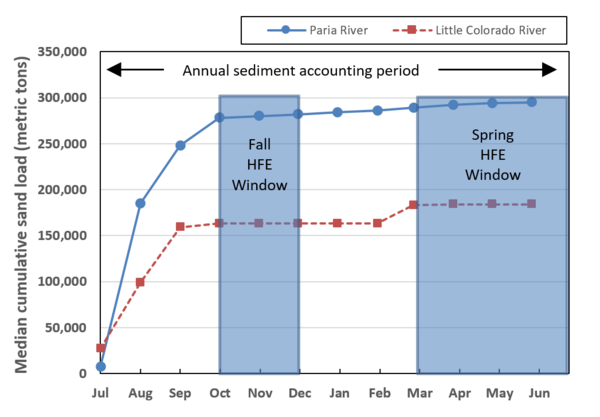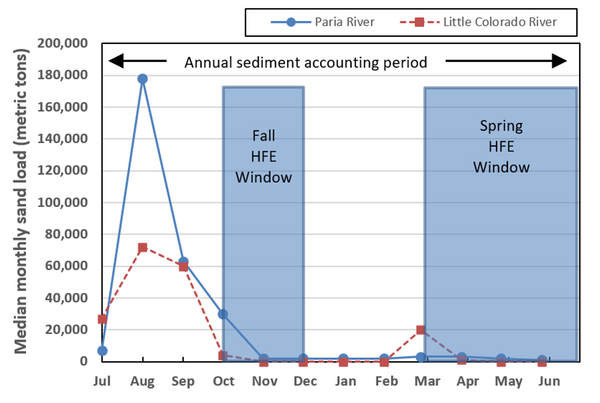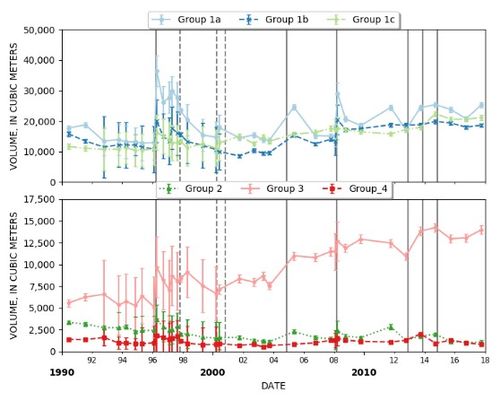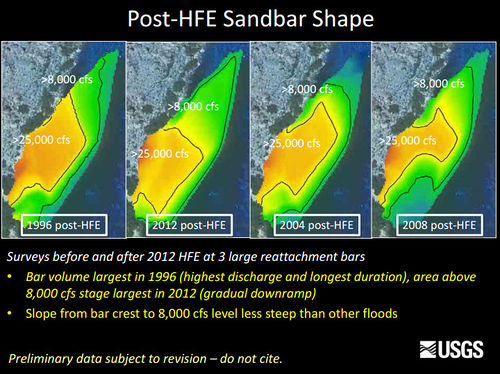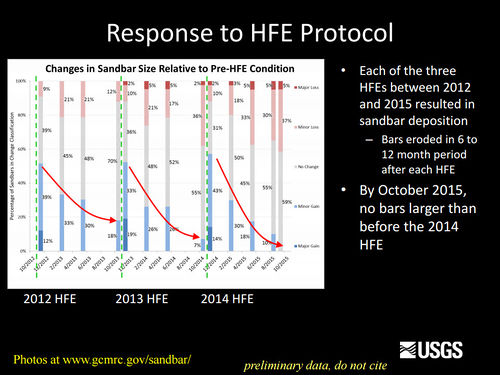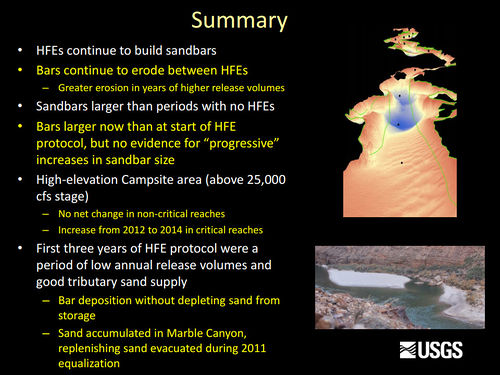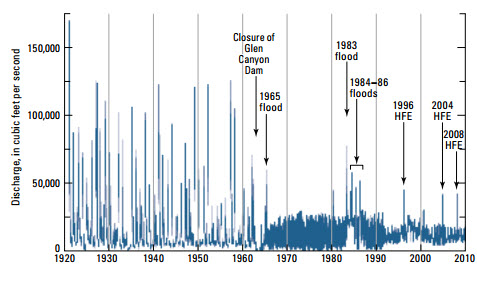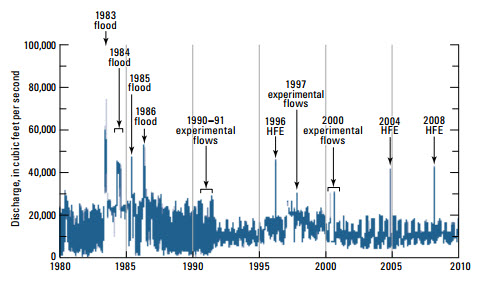|
|
|
The 2024 LTEMP SEIS adjusted the semiannual sediment accounting period to an annual period (beginning July 1) with the option for a spring or fall HFE release, or both. If a sediment trigger is met, but an HFE release is not implemented in the fall or spring, rollover of sediment into the next accounting period is possible. Implementation of a fall HFE can occur in October or November. Spring implementation could occur from March through June, depending on resource conditions and the potential for implementation of the 2024 LTEMP SEIS cold-water alternatives that include flow spikes. [1]
|
LTEMP Experimental Action: Sediment-Related Experimental Treatments (Table 2-2, pages 11-12) [2]
|
|
Under Alternative D, the existing HFE protocol was updated and incorporated into the LTEMP process as specified in Appendix P of the FEIS. Changes to the existing protocol were related to implementation of the new HFEs that are included under Alternative D and an B-17 extension of the protocol to the end of the LTEMP period. This new protocol will replace the existing protocol when the LTEMP ROD is issued. Spring and fall HFEs will be implemented when triggered during the 20-year LTEMP period based on the estimated sand mass balance resulting from Paria River sediment inputs during the spring and fall accounting periods, and the dam release pattern during the accounting period. HFE releases will be 1 to 250 hr long and between 31,500 cfs and 45,000 cfs. Depending on the cumulative amount of sediment input from the Paria River during the spring (December 1 through June 30) or fall (July 1 through November 30) accounting periods and the expected accumulation of sand, the maximum possible magnitude and duration of HFE that would achieve a positive sand mass balance in Marble Canyon, as determined by modeling, will be implemented.
Sand mass balance modeling will be used to ensure that the duration and magnitude of an HFE are best matched with the mass of sand present in the system during a particular release window. The magnitude and duration of HFEs will not affect the total annual release from Glen Canyon Dam. Reclamation will consider the total water to be released in the water year when determining the magnitude and duration of an HFE. [3]
Sediment-Triggered Spring HFEs
- HFE window: Mar-Apr
- Up to 96 hrs
- Could begin after the first two years of LTEMP (start spring 2020),
- Not in the same water year as an extended-duration (>96 hr) fall HFE
Proactive Spring HFEs
- Triggered by an annual release volume over 10.0 maf
- HFE window: Apr-Jun
- Up to 24 hrs
- Not in the same water year as a sediment-triggered spring HFE or an extended-duration (>96 hr) fall HFE
Sediment-Triggered Fall HFEs
- HFE window: Oct-Nov
- Up to 96 hrs
Extended-Duration Fall HFEs
- HFE window: Oct-Nov
- Up to 250 hrs
- The first test would be limited to 192 hrs
- No more than four during the 20-year LTEMP period
|
The Planning and Implementation (P&I) Process
|
|
1.4 COMMUNICATION AND CONSULTATION PROCESS FOR ALTERNATIVE D
To determine whether conditions are suitable for implementing or discontinuing experimental treatments or management actions, the DOI will schedule implementation/planning meetings or calls with the DOI bureaus (USGS, NPS, FWS, BIA, and Reclamation), WAPA, AZGFD, and one liaison from each Basin State and from the UCRC, as needed or requested by the participants. The implementation/planning group will strive to develop a consensus recommendation to bring forth to the DOI regarding resource issues as detailed at the beginning of this section, as well as including WAPA’s assessment of the status of the Basin Fund. The Secretary of the Interior will consider the consensus recommendations of the implementation/planning group, but retains sole discretion to decide how best to accomplish operations and experiments in any given year pursuant to the ROD and other binding obligations. (B-17 in the LTEMP ROD)
|
Updates
|
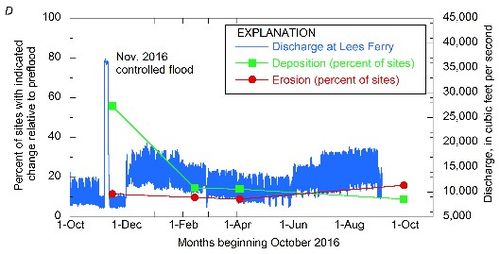 Rate of post-HFE beach erosion
|
|
Links and Information
|
|
|
Glen Canyon Dam Flow Experiments
|
|
|
Presentations and Papers
|
|
2024
2023
2022
2021
2020
2019
2018
2017
2016
2014
2013
2012
2011
2010
2009
1997
1996
|
2019 HFE Workshop
|
|
In lieu of the motion by Recreational Fishing representatives proposed for this meeting, GCMRC has agreed to:
(1) conduct a scientific assessment of the effects of past experimental high flows (including
powerplant capacity flows) at Glen Canyon Dam on high valued resources of concern to
the GCDAMP (i.e., recreational beaches, aquatic food base, rainbow trout fishery,
hydropower, humpback chub and other native fish, and cultural resources); and
(2) present initial findings in a written summary at the 2019 Annual Reporting Meeting and
the March 2019 AMWG meeting for review and discussion.
A next step would be for GCMRC to identify experimental flow options that would
consider high valued resources of concern to the GCDAMP (defined above), fill critical
data gaps, and reduce scientific uncertainties. [4]
|
2015 HFE Synthesis Workshop
|
|
|
2010 HFE Workshop
|
|
|
|
|
|
|
Power Plant Capacity Flow Tests
|
- Habitat Maintenance Flow (HMF) – September 1997
- Low Summer Steady Flow: April – September 2000; Included two powerplant-capacity flows, one in May and one in September
- California power emergencies 2000 - 2001: Included six powerplant capacity flows
|
HFEs and the Colorado River Basin Project Act of 1968
|
|
One area that has been a source of recent discussion has been the question of planned high releases from Glen Canyon Dam for such purposes as "beach habitat building flows." The Department expects the AMWG to work and provide its recommendations within the following context. Since the GCPA is clear that it was not intended to modify the compacts or "the provisions of the Colorado River Storage Project Act of 1956 and the Colorado River Basin Project Act of 1968 that govern allocation, appropriation, development, and exportation of the waters of the Colorado River Basin" (GCPA, section 1802(b)), any operational changes under the auspices of the GCPA are clearly subordinate to and must fit within the constraints of those provisions. Historically, there have been differences of legal opinion over some related issues, such as whether releases of water above power plant capacity, if made for authorized purposes, can be considered as not constituting "spills" within the meaning of section 602(a) of the Colorado River Basin Project Act of 1968 and the Operating Criteria implemented pursuant to section 602, and more recently over whether the GCPA "amends" existing law by adding additional authorized purposes for the operation of Glen Canyon Dam. These legal issues have not been finally resolved, but given the limitations provided in the ROD, the Glen Canyon Dam operating criteria, and the 1996 agreement between the Department and the Basin States, it is believed that they have been adequately addressed. [5]
|
Other Stuff
|
Calculating the Cumulative Sand Load for an HFE
- Determine the amount of sand that has come in from the Paria River during the HFE Accounting Period you are interested in. Go to the Paria River gage at Lees Ferry and check the Cumulative Sand Load box and enter the dates of the HFE Accounting Period.
- Determine the amount of sand that has been transported out of Marble Canyon during the HFE accounting period by taking the lower bound value of the change in sand storage in Lower Marble Canyon and subtracting it from the lower bound value of the change in sand storage in Upper Marble Canyon.
- Subtract the amount of sand that has been transported out of Marble Canyon from the amount of sand that has come in from the Paria River and you get the amount of sand Reclamation uses for planning the HFE.
Calculating Magnitude and Duration of an HFE
Reclamation takes the amount of sand calculated above and subtracts the amount of sand that will be transported out of Marble Canyon between the time of the model run and the HFE. Reclamation then calculates the largest possible volume and duration release from the dam using the Scott Wright sediment transport model that does not result in a negative sand balance between the 30-mile gage and the LCR by the end of the accounting period.
How much water can be released at Glen Canyon Dam?
- 8 generators = 31,500 cfs
- 4 bypass tubes = 15,000 cfs
- 2 spillways (require reservoir elevations above 3648') = up to 208,000 cfs
How often would an HFE be triggered? (LTEMP Appendix P)
- Proactive Spring HFEs: 10% of years
- Sediment-triggered Spring HFEs: 26% of years
- Sediment-triggered Fall HFEs: 77% of years
- Extended-Duration Fall HFEs: 25% of years
|
|
